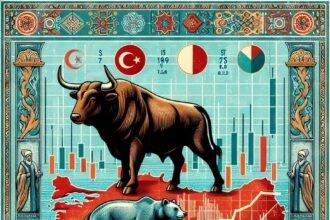[SINGAPORE] For over three-quarters of a century, the US dollar (USD) has stood as the world’s principal reserve currency, following the US-led global order after World War II.
Its enduring preeminence, demonstrated by a dominant share of about 59 to 60 per cent of global foreign exchange (FX) reserves, has conferred unique advantages on the US – from lower borrowing costs to having a potent instrument of foreign policy through financial sanctions.
However, history shows that no currency’s dominance is eternal. Recent geopolitical shifts and evolving national policies now prompt a critical examination of the USD’s long-term trajectory and its profound implications for investors worldwide.
Cracks: protectionism and weaponisation
Despite its entrenched position, recent developments have introduced significant strains. The Trump administration’s volatile trade policies and the “big and beautiful budget”, which incurs one of the largest peacetime deficits, have raised debates on the long-term debt sustainability of the US and the USD as a store of value.
The increasing “weaponisation” of the dollar through financial sanctions as a foreign policy tool has created a strong incentive for “de-dollarisation” efforts, as countries seek to reduce their vulnerability to the US financial ecosystem.
Russia and China are increasingly settling bilateral trade in their national currencies, while the Brics group is actively exploring alternative payment systems and even considering a new reserve currency. Since 2022, this trend has been manifested in the steady increase in the central banks’ purchase of gold.
BT in your inbox

Start and end each day with the latest news stories and analyses delivered straight to your inbox.
Conditions for a paradigm shift
While the dollar’s dominant share of global reserves has seen a slight decline from 71.1 per cent in 2000 to 57.8 per cent in 2024, its challengers face significant hurdles.
A true paradigm shift in the international monetary system, leading to the dollar losing its dominant status, would hinge on several critical conditions. First is a sustained erosion of international confidence in the dollar. This could stem from persistent US trade and fiscal deficits, rising government debt, political instability or the continued “weaponisation” of the dollar.
Second is the emergence of a credible and viable alternative capable of fulfilling all core reserve currency functions – a stable store of value, widely accepted medium of exchange and reliable unit of account. Major geopolitical realignments, such as a decline in overall US global influence or its relative economic size, could prompt countries to diversify away from dollar reliance.
Finally, for any challenger currency to gain serious traction, the issuing country or bloc must possess highly developed, liquid and transparent financial markets with minimal capital flow restrictions. While there is no single substitute for the USD, incremental shifts could still occur as investors diversify to a basket of non-USD currencies.
On these criteria, the euro looks like a credible diversification candidate given its 20 per cent share in reserve holdings, but it lacks the financial market’s depth. However, the European Central Bank’s institutional independence is arguably less subject to political interference and rules around deficits could introduce some degree of fiscal discipline. While China possesses a huge economy and commands a dominant trade position, its path to dominance is impeded by strict capital controls and limited access by foreign investors to its domestic asset markets.
Implications for investors
A decline in dollar dominance would have important ramifications for investors. Currently, global benchmarks such as the MSCI World or the Bloomberg Barclays Global Aggregate are capitalisation-weighted, which confer a dominant allocation to US assets. Accordingly, many strategic asset allocation decisions are guided by these benchmarks, thereby exposing investors to US assets by default.
For fixed income investors, where yields are capped, currency risks can be significant. Investors could hedge the currency risk through a simple forward contract, but hedging costs can be high, which for the case of the Singapore dollar, are over 2 per cent annually now. Hence, non-US based investors should consider hedging a larger portion of their USD exposure and maintain a diversified basket of currencies.
While a weakening dollar might seem to undermine US equity’s total return, the reality is a bit more nuanced. Equities, as an asset class, are inherently more volatile and have higher potential returns. As a result, FX effects play a secondary role.
Equities also have some natural FX hedging qualities. For instance, US multinationals, with their rising share of international revenues – from around 20 per cent in the early 1990s to roughly 40 per cent today – may see their earnings being boosted by a weaker dollar.
The US market continues to be viewed as an attractive growth opportunity, with a high concentration of profitable growth companies not seen elsewhere. US equities, particularly mega-cap technology firms, have become consistently profitable and highly cash-flow generative. US exceptionalism is as much about US companies’ superior corporate business model and earnings as it is about the US’ exorbitant privilege.
Emerging market (EM) assets are also beneficiaries of dollar softness, as a weaker dollar lowers debt servicing burdens of USD-denominated liabilities and eases EM liquidity conditions, boosting corporate earnings and investor flows. EM equities are already showing signs of a long-term bottoming relative to global ex-US stocks.
If a global rebalancing aimed at reducing the US’ persistent trade deficits is pursued, economies outside the US will have to lower their savings rate, which may lead to higher consumption and growth. Hence, while US equities have been the standout outperformer, investors should consider opportunities outside the well-known US companies.
Gold and other commodities also benefit from a weaker dollar and often signal easing global financial conditions. Gold has a strong inverse correlation with the dollar and benefits from lower US real yields and continued buying by central banks, making it an attractive store of value in diversified portfolios.
Hence, while the USD’s dominant position is under increasing scrutiny, a swift and complete displacement appears improbable soon. The dollar still benefits from strong network effects, its pivotal role in commodity trade, and safe-haven status.
The long-term trajectory suggests a gradual evolution towards a more diversified, multipolar international currency system.
The writer is chief investment officer, UOB Private Bank





















